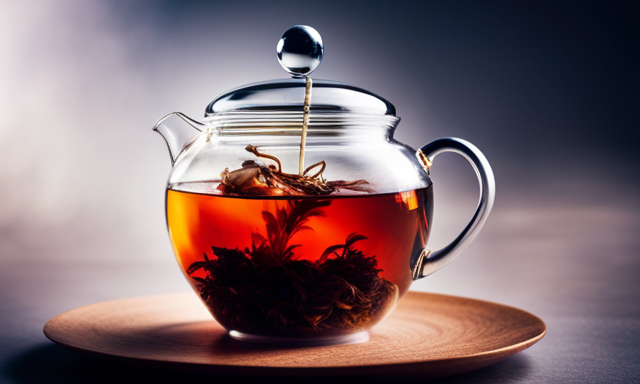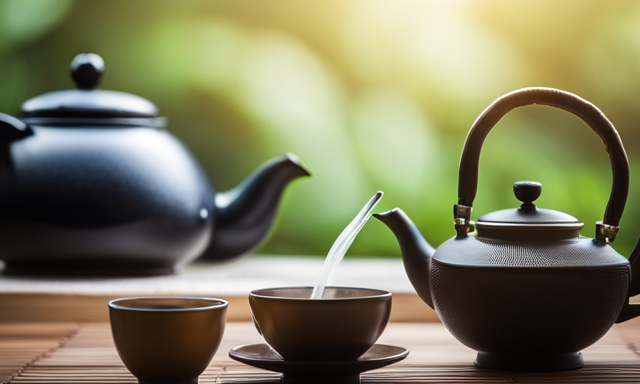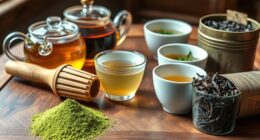Have you ever wondered about the benefits of oolong tea? Well, let me shed some light on this delightful beverage.
Oolong tea is a traditional Chinese tea that undergoes partial oxidation, giving it a unique taste and aroma. This special processing method sets it apart from both black and green teas.
But what does oolong tea actually do? Allow me to tell you.
First and foremost, oolong tea is known for its ability to boost metabolism and promote weight loss.
Additionally, it contains powerful antioxidants that fight against free radicals, protecting your body from damage.
This tea also supports heart health by lowering cholesterol levels and improves digestion and gut health.
Not only that, but oolong tea enhances mental alertness and focus, giving you the extra edge you need.
Lastly, it strengthens the immune system, making it an excellent addition to your daily routine.
So, let’s dive deeper into the world of oolong tea and discover its amazing benefits.
Key Takeaways
- Oolong tea helps regulate blood sugar levels and manage diabetes.
- Oolong tea improves digestion, reduces bloating, and promotes gut health.
- Oolong tea enhances mental alertness, focus, and brain function.
- Oolong tea strengthens the immune system, fights viral infections, and supports overall wellness.
An Introduction to Oolong Tea
Imagine yourself sipping on a warm cup of oolong tea, a delightful beverage that falls between black and green tea in terms of oxidation. Oolong tea is known for its unique taste and numerous health benefits. Understanding the benefits of oolong tea is essential to fully appreciate its value.
This tea is rich in antioxidants, which help fight free radicals in the body and reduce the risk of chronic diseases. It also contains caffeine, which can provide a gentle energy boost without the jitters often associated with coffee. Oolong tea is also believed to aid in weight management and improve digestion.
Brewing techniques play a crucial role in extracting the best flavors from oolong tea leaves. Understanding the production process further enhances our appreciation for this exceptional beverage.
Understanding the Production Process
In understanding the production process of oolong tea, there are two key points to consider: partial oxidation and unique flavor profiles, as well as the variations in oxidation levels.
Partial oxidation gives oolong tea its distinct taste and aroma. It strikes a balance between the freshness of green tea and the richness of black tea. This process allows for a wide range of flavor profiles to emerge. Oolong teas can be light and floral or dark and toasty, depending on the level of oxidation.
Speaking of oxidation levels, they can vary greatly in oolong tea production. This variation results in different types of oolong teas, each with its own unique characteristics and complexities.
Understanding the production process of oolong tea involves grasping the significance of partial oxidation and its impact on flavor profiles. It also entails recognizing the variations in oxidation levels and how they contribute to the diversity of oolong teas.
Partial Oxidation and Unique Flavor Profiles
When you drink oolong tea, it’s like taking a sip of a sunset. Its unique flavor profile comes from its partial oxidation process, giving it a distinct taste that is neither fully black nor fully green.
Here are four reasons why oolong tea’s flavor profile is so special:
- Delicate floral notes dance on your palate, reminiscent of a blooming garden.
- A gentle sweetness lingers, like the last rays of sunlight on a summer evening.
- Subtle hints of fruit add a refreshing twist, like biting into a perfectly ripe peach.
- A mild earthiness anchors the flavors, grounding the experience in nature’s embrace.
These flavor profiles are a result of the careful balance between oxidation and non-oxidation during production.
As we move on to variations in oxidation levels, we will explore how different levels of oxidation further shape the taste of oolong tea.
Variations in Oxidation Levels
To truly appreciate the nuanced flavors of oolong tea, you need to explore the variations in oxidation levels. Oxidation levels play a crucial role in determining the taste and aroma of oolong tea.
The process of tea fermentation, which involves exposing the tea leaves to oxygen, is responsible for this oxidation. The degree of oxidation can range from lightly oxidized to heavily oxidized, resulting in different flavor profiles.
Lightly oxidized oolong teas tend to have a floral and fruity taste, while heavily oxidized ones have a deeper, roasted flavor. These variations in oxidation levels provide a wide range of options for tea enthusiasts to explore and enjoy.
Understanding the impact of oxidation on oolong tea is essential in discovering your preferred flavor profile.
Transitioning into the subsequent section, exploring the health benefits of oolong tea reveals its potential for boosting metabolism and promoting weight loss.
Boosting Metabolism and Promoting Weight Loss
Rev up your metabolism and shed those extra pounds with the powerful effects of oolong tea, all while enjoying its rich and satisfying flavor. Here are three ways oolong tea can help boost your metabolism and promote weight loss:
-
Boosting energy levels: Oolong tea contains caffeine and other stimulants that can increase your energy levels, helping you feel more active and burn more calories throughout the day.
-
Reducing inflammation: Chronic inflammation in the body can hinder weight loss efforts. Oolong tea has been shown to have anti-inflammatory properties, which can help reduce inflammation and promote weight loss.
-
Enhancing fat burning: Oolong tea has been found to increase fat oxidation, meaning it helps your body burn more fat for energy. This can potentially lead to weight loss over time.
With its antioxidant properties and ability to fight free radicals, oolong tea offers even more health benefits beyond weight loss.
Antioxidant Properties and Fighting Free Radicals
With its powerful antioxidant properties, oolong tea acts as a shield against free radicals, safeguarding our bodies from potential harm. Antioxidants are compounds that help prevent cell damage by neutralizing harmful molecules called free radicals. These free radicals can cause oxidative stress, which has been linked to various chronic diseases, including cancer and heart disease. Oolong tea is rich in antioxidants such as polyphenols, which have been shown to have numerous health benefits. Research suggests that regularly consuming oolong tea may help reduce the risk of chronic diseases by preventing cell damage and inflammation. Additionally, oolong tea has been found to improve skin health and promote healthy aging. As we move into the next section, let’s explore how oolong tea supports heart health and lowers cholesterol levels.
Supporting Heart Health and Lowering Cholesterol Levels
Improve your heart health and lower cholesterol levels with the support of oolong tea’s beneficial properties. Oolong tea contains compounds that have been shown to promote heart health and reduce cholesterol levels. Here are four ways oolong tea can benefit your heart and cholesterol:
-
Reduces LDL cholesterol: Oolong tea has been found to lower levels of LDL, or ‘bad’ cholesterol, which can contribute to heart disease.
-
Increases HDL cholesterol: Oolong tea has also been shown to increase levels of HDL, or ‘good’ cholesterol, which helps remove LDL cholesterol from the bloodstream.
-
Lowers blood pressure: Regular consumption of oolong tea has been associated with lower blood pressure levels, reducing the risk of heart disease.
-
Supports blood vessel health: Oolong tea contains antioxidants that promote blood vessel health, reducing the risk of plaque buildup and improving overall heart health.
By incorporating oolong tea into your diet, you can support your heart health and maintain healthy cholesterol levels.
Transitioning into the next section, managing diabetes and regulating blood sugar levels is another important aspect of oolong tea’s benefits.
Managing Diabetes and Regulating Blood Sugar Levels
Take control of your diabetes and regulate your blood sugar levels by incorporating the amazing benefits of oolong tea into your daily routine.
Oolong tea has been shown to be effective in managing diabetes and regulating blood sugar levels. Research suggests that oolong tea can help reduce blood sugar spikes after meals, improve insulin sensitivity, and enhance glucose metabolism.
The polyphenols found in oolong tea may also have a positive impact on pancreatic function, which plays a crucial role in blood sugar regulation.
Additionally, oolong tea contains antioxidants that can help reduce oxidative stress, a common factor in diabetes.
By including oolong tea in your diet, you may be able to better manage your diabetes and maintain stable blood sugar levels.
As we transition to the next section, let’s explore how oolong tea can improve digestion and promote gut health.
Improving Digestion and Gut Health
By incorporating oolong tea into your daily routine, you’ll experience a soothing sensation as your digestive system dances with delight and your gut health flourishes. Oolong tea is known to improve digestion and promote gut health in several ways.
Firstly, it aids in improving nutrient absorption by increasing the activity of digestive enzymes in the gut. This means that your body can effectively break down and absorb essential nutrients from the food you consume.
Additionally, oolong tea has been found to reduce bloating, which can be caused by gas and inflammation in the digestive system. The polyphenols present in oolong tea help to relax the muscles in the digestive tract, reducing discomfort and bloating.
With improved digestion and reduced bloating, you’ll be ready to explore the next section on enhancing mental alertness and focus seamlessly.
Enhancing Mental Alertness and Focus
Boost your cognitive abilities and stay sharp throughout the day by incorporating oolong tea into your daily routine. Oolong tea has been shown to have several benefits for enhancing mental alertness and focus.
Here are five ways oolong tea can enhance productivity and increase mental clarity:
- Oolong tea contains caffeine, which can improve alertness and concentration.
- It also contains L-theanine, an amino acid that has been found to promote relaxation and reduce stress, leading to improved focus.
- Oolong tea has been shown to increase brain function and improve memory and learning abilities.
- The antioxidants in oolong tea can protect brain cells from damage and may help prevent age-related cognitive decline.
- Oolong tea has been linked to improved productivity and creativity, making it a great choice for those looking to boost their mental performance.
Incorporating oolong tea into your daily routine can have a positive impact on your mental abilities.
Additionally, oolong tea has many other health benefits, including strengthening the immune system.
Strengthening the Immune System
Strengthen your immune system and feel invincible with the powerful benefits of incorporating oolong tea into your daily routine. Oolong tea contains a variety of antioxidants and compounds that can enhance your immune response and promote overall wellness. Studies have shown that oolong tea can help strengthen the immune system by increasing the production of immune cells and improving their function. These immune-boosting properties can help protect against common illnesses and infections.
To give you a closer look at the immune-enhancing benefits of oolong tea, here is a comparison table:
| Benefits of Oolong Tea | Description |
|---|---|
| Rich in Antioxidants | Protects against free radicals and strengthens immunity |
| Boosts Immune Cell Production | Enhances the body’s defense mechanism |
| Supports Overall Wellness | Promotes a healthy immune system and reduces illness |
| Fights Viral Infections | Helps combat common viruses and reduces their severity |
By incorporating oolong tea into your daily routine, you can strengthen your immune system and enjoy the many health benefits it offers. It’s time to take charge of your well-being and make oolong tea a part of your healthy lifestyle. Transitioning into the next section, let’s explore how to incorporate oolong tea into your daily routine for maximum benefits.
Incorporating Oolong Tea into Your Daily Routine
Get ready to revolutionize your daily routine with a simple yet powerful addition that will have you feeling like a wellness guru in no time. Incorporating oolong tea into your daily routine can bring numerous health benefits. Here are four ways you can easily make oolong tea a part of your everyday life:
-
Start your day with a cup of oolong tea: Replace your morning coffee with a soothing cup of oolong tea. Its moderate caffeine content provides a gentle energy boost without the jitters.
-
Enjoy oolong tea as an afternoon pick-me-up: Instead of reaching for sugary snacks, sip on a cup of oolong tea to satisfy your cravings and keep you focused and alert.
-
Make oolong tea your post-meal ritual: Oolong tea can aid digestion and help regulate blood sugar levels. Enjoy a cup after meals to support a healthy digestive system.
-
Wind down with a cup of oolong tea before bed: Oolong tea contains theanine, an amino acid that promotes relaxation and improves sleep quality. Savor a cup before bedtime to unwind and prepare for a restful night.
By incorporating oolong tea into your daily routine, you can experience the wonderful benefits it has to offer.
Frequently Asked Questions
Can oolong tea help with acne or other skin conditions?
Yes, oolong tea can help with acne and other skin conditions. It contains antioxidants that reduce inflammation and fight acne-causing bacteria. Additionally, oolong tea promotes healthy skin by improving skin tone and reducing signs of aging.
Is it safe to drink oolong tea during pregnancy or while breastfeeding?
Is it safe to drink oolong tea during pregnancy or while breastfeeding? Safety precautions during pregnancy should be taken, as oolong tea contains caffeine. However, oolong tea can provide benefits for breastfeeding mothers, such as hydration and antioxidant support.
Does oolong tea contain caffeine, and if so, how does it compare to other types of tea?
Oolong tea does contain caffeine, but the amount can vary depending on the type and brewing method. Compared to other teas, oolong tea generally has less caffeine. It also has potential weight loss benefits.
Can oolong tea help with hair growth or prevent hair loss?
Oolong tea cannot directly help with hair growth or prevent hair loss. While it contains antioxidants and nutrients that promote overall health, there is no scientific evidence linking it specifically to hair-related benefits.
What is the best way to brew and prepare oolong tea for maximum health benefits?
To brew and prepare oolong tea for maximum health benefits, I recommend using high-quality loose leaves, steeping them in hot water for 3-5 minutes, and then enjoying the delicious and nourishing beverage.
Conclusion
In conclusion, incorporating oolong tea into my daily routine has been a game changer for my overall well-being. Not only does it taste delicious, but it is also packed with numerous health benefits.
One interesting statistic that truly amazed me is that oolong tea has been found to boost metabolism by up to 10%. This means that by simply enjoying a cup of oolong tea, I can support my weight loss goals and feel energized throughout the day.
It’s incredible how a small change in our daily habits can have such a big impact on our health.










